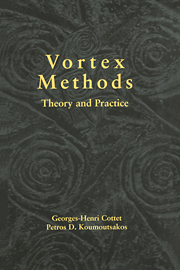Book contents
- Frontmatter
- Contents
- Preface
- 1 Definitions and Governing Equations
- 2 Vortex Methods for Two-Dimensional Flows
- 3 Three-Dimensional Vortex Methods for Inviscid Flows
- 4 Inviscid Boundary Conditions
- 5 Viscous Vortex Methods
- 6 Vorticity Boundary Conditions for the Navier–Stokes Equations
- 7 Lagrangian Grid Distortions: Problems and Solutions
- 8 Hybrid Methods
- Appendix A Mathematical Tools for the Numerical Analysis of Vortex Methods
- Appendix B Fast Multipole Methods for Three-Dimensional N-Body Problems
- Bibliography
- Index
Appendix A - Mathematical Tools for the Numerical Analysis of Vortex Methods
Published online by Cambridge University Press: 21 September 2009
- Frontmatter
- Contents
- Preface
- 1 Definitions and Governing Equations
- 2 Vortex Methods for Two-Dimensional Flows
- 3 Three-Dimensional Vortex Methods for Inviscid Flows
- 4 Inviscid Boundary Conditions
- 5 Viscous Vortex Methods
- 6 Vorticity Boundary Conditions for the Navier–Stokes Equations
- 7 Lagrangian Grid Distortions: Problems and Solutions
- 8 Hybrid Methods
- Appendix A Mathematical Tools for the Numerical Analysis of Vortex Methods
- Appendix B Fast Multipole Methods for Three-Dimensional N-Body Problems
- Bibliography
- Index
Summary
The goal of this appendix is to provide the mathematical background needed in the numerical analysis of vortex methods and, more generally, particle methods.
The two first sections are devoted to particle approximations of the solutions to advection equations. The third section summarizes some mathematical features of the Navier–Stokes equations. The numerical analysis carried out in Chapters 2 and 3 results from a combination of the results hereafter derived.
As we have seen in several occasions, the basic feature of vortex methods is that the data, that is the initial vorticity and the source terms at the boundary, are discretized on Lagrangian elements where the circulation is concentrated. These elements are termed particles, and mathematically they consist in delta functions. In Section A.1 we answer the following question: in which sense can a set of particles be used to approximate a given smooth function? We then proceed in Section A.2 to demonstrate that particles moving along a given flow are explicit exact weak solutions, in a sense that we precisely define, of the corresponding advection equation. This is the mathematical reason why particle methods are suitable for the numerical approximation of transport equations. We then show stability properties for the weak form of the transport equation. Together with the results of Section A.1, these stability estimates are the central tool for the numerical analysis of particle methods for linear equations.
- Type
- Chapter
- Information
- Vortex MethodsTheory and Practice, pp. 261 - 283Publisher: Cambridge University PressPrint publication year: 2000

